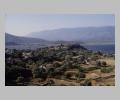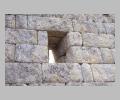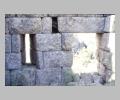| Summary: | A Carian city refounded and enlarged in the Hellenistic period. |
| Type: | Fortified city |
| Region: | Caria |
Periods:
Archaic
Classical
Hellenistic
Roman
Physical:
Located on the S slopes of Mount Latmus and ca. 25 km W of Miletus, Heralkeia under Latmos was originally a port city at the extreme SE corner of the Latmian gulf. As the Meander silted its delta a swamp developed at Miletus and the freshwater lake of Barfa was formed at the SE.
The 3rd century B.C. city of Heralkeia (a refoundation of the earlier city of Latmos 1 km to the E) had a circuit of well-built fortification walls that extended over 6 km in length and ran from the fortified harbor northwards into the rugged upper slopes of Mt. Latmus. The walls supported 65 towers and numerous gates and postern gates. They are among the best preserved in the ancient world and details of parapets, windows, foundation cuttings in bedrock, and even roofs can still be seen today.
The new city was planned in the Hippodamian grid system with major streets running due N from the fortified harbor. At the center of the city is a rectangular agora (60 x 130 m) with a two story row of shops still preserved along the southern edge. East of the agora is the bouleuterion. The main temple of the city, the temple of Athena, is one of the few structures not aligned to the city grid. It sits on a prominent rocky spur to the west of the agora. The area of the city N of the agora is less well known, but remains of three temples, a Roman bath, a Roman theater, and a nymphaeum have been identified. South of the agora, on a rise overlooking the lake is another structure not aligned to the grid. This is a sanctuary with a SW facing building that was almost certainly dedicated to Endymion. The unusual horseshoe-shaped rear wall of the cella incorporates sections of natural bedrock and may well be a reflection of Endymion's cave.
The original settlement of Latmos, 1 km to the E served the later city as a necropolis, as did all the area S and E of the 3rd century city walls of Herakleia.
Description:
Originally a Carian city on the edge of Ionian territory, Latmus became a member of the Delian League in the 5th century B.C. In the 4th century B.C. Mausolos of Halikarnassos captured the city by trickery and fortified it with a circuit wall.
At the beginning of the 3rd century B.C., with the removal of Persian influence in Anatolia, a new city of Latmus was established ca. 1 km W of the old city. At this time, or slightly earlier under the Hellenizing policy of Mausolos, the city received the new name of Herakleia.
The city was always overshadowed by nearby Miletus which was more favorably located at the opening of the Latmian gulf. Although new construction continued at Herakleia during the Hellenistic and Roman periods, the silting of the Meander river closed the gulf and by the 1st century B.C. the harbor of Herakleia no longer had access to the Aegean Sea and the gulf before Herakleia was transformed into the large freshwater lake Bafa.
The city of Latmus-Herakleia was well known in antiquity for its association with the myth of Endymion, a demi-god who chose to avoid death and old age by sleeping forever in a cave on sacred Mt. Latmus. In the 7th century A.D. communities of Christian monks who had fled Arabia were drawn to Herakleia and Lake Barfa by the plentiful supply of fish and the many caves and natural wild character of the terrain. The Endymion myth was given a Christian interpretation and many pilgrims visited the region.
Exploration:
Chandler visited the site in 1765. Since then there has been some study of the visible remains, but no systematic excavation at the site.
Sources Used:
Other Bibliography:





